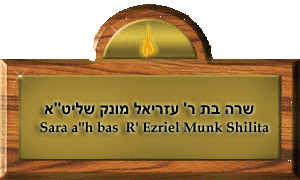
A Prayer at the Western Wall
Sponsored by Pirchei Shoshonim
Now Available -
MONTHLY AND WEEKLY SPONSORSHIP FOR THIS SITE!

If you would like, you may fill out the following form and have your own petition inserted into a crack in the Wall. You may also request that Kaddish (prayer for the departed) be said for a loved one, or for Torah learning to be done in the "credit" of a specific person. Tehillim (psalms) can also be said on your behalf. You may also request that a mishaberach (welfare prayer), prayer for a speedy recovery, be said for someone.
We ask all those to please donate at least 18 -36 dollars for this service. One can do so via credit card through our paypal account, or by sending a check to Pirchei Shoshanim, P.O.B. 708, LAKEWOOD, N.J. 08701, which is a tax free donation.
For over two thousand years, since the destruction of the Holy Temple, the Kotel HaMaaravi, Western Wall, had been the Jewish focal point for prayer . When Jews pray, no matter where, in any synagogue or home, they face the direction of this last standing remnant of the Temple. Tourists visiting Israel from all over the world, feel compelled to experience the Kotel. In Jerusalem, where one can feel a special holiness in the air, this sensitivity is most pronounced at the Wall.
At the Kotel, people pour out their hearts to G-d, in a variety of languages, at all hours of the day and night. Minyanim, or prayer quorums, are organized spontaneously throughout the day. Men in long black Hassidic garb, Western tourists with slung cameras, hippies on world adventures--all of these and more can be found mingling, finding solace, questioning, or experiencing a religious high at the Wall. Even late into the night and in the wee hours of the morning, whispered prayers can be heard.
Where the Holy Temple, Beit HaMikdash stood has always been considered the "shortest route" to G-d's ear. Certainly, prayers said in any part of the world will reach G-d. But it is said that "G-d's Presence" in this world was situated specifically in this holy place. This is, so to speak, G-d's abode. As such, petitions made in this place have less "travel time" than petitions made elsewhere.
One tradition going back hundreds of years is to place a prayer, written on a small piece of paper, or Tzetel into a crack in the Wall. Many tears have been shed as a "Tzetel" has been pressed into the Wall. Perhaps one is asking for a speedy recovery for a sick person, another may be seeking his soul mate, yet another may be asking for G-d's guidance for a personal problem. No matter what the petition, a feeling that one's burdens are being shared and will be alleviated, is often felt after the tzetel, with sincere prayer, is inserted into the Wall.
Please send us your problems or questions to webmaster@shemayisrael.co.il